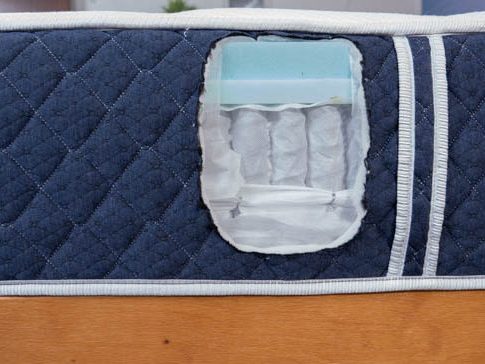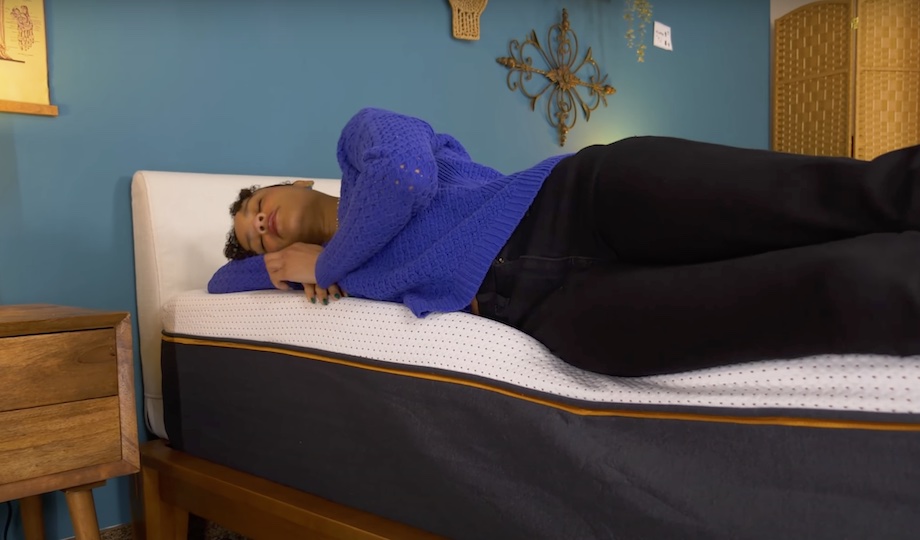Selling mattresses online has revolutionized the sleep industry in many ways. Consumers have access to more options, including lower prices on higher-end beds.
We know it can be tough to navigate the world of online mattress shopping, and we understand the cost of such a purchase can be a major concern for many shoppers. This guide will help you discover the cost of a mattress and what factors may be involved in determining that, along with some helpful tips on how to save more money.
Average Mattress Price by Type and Category
These prices are averages and can vary based on the brand and any sales happening at the time of purchase.
| Mattress Type | Description | Average Queen-Size Price (Budget Model) | Average Queen-Size Price (Mid-Range Model) | Average Queen-Size (Luxury Model) |
|---|---|---|---|---|
| Innerspring | Coil support layer with a thin comfort layer | $500 | $1,000 | $1,500 |
| Memory Foam | Made entirely out of foam | $300 | $1,000 | $1,500 |
| Hybrid | Coil support layer with more than one comfort layer | $1,000 | $2,000 | $2,500 |
| Latex | Only latex or latex with other materials | $1,000 | $2,000 | $2,500 |
Get More Info: Best Mattress 2024
What Factors Influence
Mattress Prices?
While mattress type influences the price, did you know that many other factors can also go into the cost of a new mattress? The market is full of options, so you can find a mattress for every budget, but it’s good to know why certain models are priced differently.
Materials and Construction
The price of a mattress often depends on multiple factors, but the materials and construction are typically the most significant ones. Some materials are more difficult to source, making them more expensive.
Foam
The price of an all-foam mattress varies depending on the foam density, type of foam used, and additional special features. Foam beds made only with poly foam will typically cost less than those that also have memory foam in them.
Higher-density foam lasts longer because it often retains its shape more easily, reducing long-term impressions. However, this can raise the cost and some shoppers may find higher-density beds to be too firm. Conversely, lower-density foams may cost less and need to be replaced more often.
The upside is that you can find a product at a mid-range price point that combines both higher and lower-density materials for a blend of comfort and durability.
Additional features that enhance the product’s usability, such as reinforced edges or cooling properties, will likely raise the cost of the bed. The tradeoff is that consumers are promised a more comfortable and convenient sleep experience. Some companies design their own foams or offer zoned materials with different compression levels.
Check Out Our Comparison: All-Foam vs. Memory Foam Beds
Innerspring
Just like a mattress made of foam, the way an innerspring mattress is built will largely determine how much companies charge their customers for it. Coil counts, gauges, comfort materials, and additives are all factors to become acquainted with when choosing an innerspring model.
Innerspring beds with higher-gauge coils are typically less expensive since high-gauge coils are usually thinner than low-gauge ones. This can cause the beds to break down quicker, driving the fees down.
The number of coils inside a mattress can also affect the price; the more coils are present, the more metal is used to create them. Many shoppers prefer a bed with more springs inside, which may help to justify the cost.
Shoppers should also consider other construction factors, like whether or not the bed has more than one spring system or if the coils are wrapped in fabric. The bed’s thickness, materials used, and cooling technologies employed will all affect the cost. Additionally, if a comfort layer is included, this could drive up the price.
Hybrid
Hybrid beds have witnessed a lot of innovation over the years, and as other products evolve, so do hybrids. Companies have begun to experiment with different construction styles and material types, which can then lead to a variety of price ranges. The cost of a hybrid is also determined by many of the same factors involved in pricing an innerspring or all-foam bed, as these products combine both springs and comfort materials like latex, foam, or both.

Some hybrid products feature taller coils or a dual-coil construction. The thickness of the comfort materials and the construction of these layers can affect the money spent to build the bed. Many of these items also include cooling technologies, pocketed springs, or enhanced edges.
Check whether the item is double-sided, as these models are often thicker and contain more materials. Certified organic models and zoned designs will also play a part in determining the cost of the item, so be sure to look into these issues as well.
Latex
There are two main production methods for latex, and each one will probably run you a different amount. These include Dunlop and Talalay.
Many sleepers consider Dunlop latex to be firmer and more durable, so this material may be seen frequently in foundation layers. Talalay is usually considered to be softer and is a good choice for adding pressure relief. In general, Talalay beds are more expensive, though there are models out there that combine both types.
Shoppers should also check to see if their latex mattress is natural or organic — these two features are not the same. A natural latex product means that the item is created using natural and not synthetic latex; some shoppers may be allergic to natural latex, but others are glad to have a product that is not chemically engineered. Natural latex beds will usually cost more.
Latex mattresses can also feature many of the same qualities found in foam, such as aeration that allows for air circulation. Some of these models may also feature enhanced edge support or zoning.
Mattress Size
Mattress size always affects the price because larger models feature more of each material. For example, when looking at a certain model, it’s easy to see why a Queen bed is more expensive than a Twin. This is the case for all brands and models, so it’s unlikely you’ll come across all sizes having the same price. However, some brands have the same price for larger sizes, like King and California King.
Explore our picks for the best beds by size:
- Best Twin Mattress
- Best Twin XL Mattress
- Best Full Mattress
- Best Queen Mattress
- Best King Mattress
- Best California King Mattress
Buying Online or In-Store
Buying online is often cheaper than buying in-store, so it’s worth considering if you’re on a budget. Manufacturers can cut costs when selling online because there are no middlemen between them and their customers. There are no costs of having a store or salesmen, so you can get the same mattress for a lot less money when buying online rather than in a brick-and-mortar store.
Trial and Warranty
The majority of bed-in-a-box businesses offer trial periods so that consumers can get an idea of how their new mattress will work for them. Since you can’t go to a store and actually lie down on the product, they give you plenty of time to test it out in your own home. Much of the time, if you return an unwanted bed within the trial period, the cost of shipping is free, but some companies may withhold a small amount while refunding the rest of your purchase.
Want to know more? See our complete guide on how to return a mattress here.
Generally, the warranty included with your purchase will ensure that you can quickly and easily replace a defective mattress within a given amount of time. Most of these arrangements will last at least 10 years, while some are extended 20 or 30 years, and in some cases, you will even be granted a lifetime warranty.

Some companies include comfort guarantees, along with their warranties, to ensure that shoppers receive proper sleep for as long as they own their mattresses. These offers usually allow people to trade in their comfort layers, or in some cases, the entire mattress, after a certain amount of years to make sure the materials do not compress too much over time.
Each company uses a different policy to determine whether exchanges under the warranty are free or not. Sometimes, this will vary depending on the size of the mattress or the amount of time elapsed before making a claim.
Read More: How Long Do Mattresses Last?
Exchanges
Some brands allow shoppers to send in their mattress or comfort materials in exchange for a different comfort level or a new model altogether. If you find yourself tossing and turning because you accidentally purchased a mattress that is too firm or soft, you could switch it out for one that suits you better. This is often free within the trial period, but after that time, there may be a fee required.
Read More: Best Mattresses Under $1000
Shipping
Much of the time, bed-in-a-box brands ship their products for free. However, there are some circumstances in which this is not possible. Some businesses will charge an additional fee to ship to Hawaii and Alaska, or companies in the United States will charge more to ship to Canada and vice versa.
You may also find it beneficial to check whether different sizes are more difficult or expensive to ship. King, Cali King, or Split sizes may be pricier. Most places will have chat representatives on hand to answer these questions.
Check Out Our Guide: Best Bed-in-a-Box
White Glove Delivery
White Glove service refers to a standard of delivery in which the company will send people to bring the bed right into your home and have them set it up for you. Some businesses offer this service for free, while others charge a nominal fee for the setup.
You should also note that white glove delivery is not always available in every location a company ships to., so it’s good to look into this ahead of purchasing. The mattress company Saatva is known for their white glove delivery.
Removal of Old Mattress
What do you do with your old bed once you get a new one? Some businesses offer a convenient service that disposes of your unwanted mattress for you. They may even find a way to recycle or donate the bed in the process, so there’s no need to cut up a whole mattress all by yourself.
Sometimes, the removal of the unwanted product is included in the White Glove service. Other times, companies will expect you to pay extra to have your old bed removed.
Platforms, Frames, and Foundations
Maybe you already have a frame or foundation, but that doesn’t always mean it will work for the mattress you choose. Many companies have specific recommendations for their beds so that they perform their best and last longer. Find out whether you’ll need to purchase a new or proprietary base if the setup you already have will work, or if the brand offers an included bed frame with purchase when choosing a mattress.
More: Best Heavy Duty Bed Frames and Best Adjustable Bed Frames
Pillows and Bedding
If you’re buying a new mattress, that could mean new pillows, sheets, and other bedding, like a comforter or duvet. In this case, you should consider those extra costs as well. If you’re buying a new mattress but the same size as your old one, you could save some money if you don’t need any new bedding for the size difference.
Additional
Buyer Considerations
Price/Value Analysis
The process of buying a mattress doesn’t always end there. There can be many other hidden costs that end up burdening your wallet. Shipping and handling, set-up fees, and other considerations may affect your bottom line.However, that doesn’t mean these extra costs aren’t worth your time. Some people are more than happy to spend a few extra bucks on white glove delivery if it saves them a little hassle.
Add-On and Hidden Costs
Generally speaking, the cheaper a mattress is, the less durable it’s likely to be, and vice versa. Of course, there are always exceptions to this rule, but many budget-friendly models reduce their expenses by using cheaper or fewer materials. However, more expensive does not always mean better, since some beds may come with features that you simply do not need or that could hinder your sleep experience.
There’s nothing wrong with buying a budget-friendly or expensive product. For the most part, however, mid-range items should offer the most bang for your buck, especially if they are offered with a lifetime warranty or comfort guarantee.
Find Out More: Best Budget Mattresses
Mattress Cost
FAQs
How can I get a mattress that costs less?
Keep in mind that sometimes the less a mattress costs, the faster it may need to be replaced, but that doesn’t mean you can’t find a great deal on a great product.
You can look for coupons that could help you save a few bucks when you purchase a new bed online. Shopping online, in and of itself, can be a great way to reduce the cost of a new mattress, as this process cuts out the expense of brick-and-mortar stores. Some brands are available through Amazon, which may offer a lower price than their home site.
Many companies offer deep discounts during certain holidays, like Presidents’ Day or Memorial Day, allowing shoppers to save hundreds of dollars.
What is the pricing difference between mattress sizes?
The cost of any size mattress will vary depending on the brand, construction materials, and features offered by the product. For example, a Twin mattress could run anywhere from $200 to $3,000, depending on all these factors. However, there are some common industry standards you can reference.
Many Twin beds range between $300 and $600. Much of the time, the sizes will rise in price by $100 or $200 from there. So, if the Twin is $400, the Full might be $600, and so on.
Occasionally, there will be special features present in the different sizes that might affect this range. A Twin or Full XL might be an extra $50-$200. Split or Cali-King beds may add more to the cost as well.
What is the average price to spend on a mattress?
The average price you should spend on a mattress depends largely on the type of mattress you’re interested in. Also, are you looking for a budget-friendly model or a luxury one? A budget-friendly option would be around $700 or less, whereas a luxury model would be around $2,000 to $3,000 for a Queen. However, this all depends on the particular model and brand.
Is $2,000 too much for a mattress?
It’s up to you to decide how much is too much for a mattress. A mattress that costs $2,000 might be a deal for some buyers and too much for others.
Therefore, it’s helpful to do your research beforehand. Look at the materials, the overall quality, and other consumer factors like the trial and warranty. You may find that $2,000 is a great deal for a specific mattress or a not-so-great deal for something else.
Is it okay to buy a cheap mattress?
There’s nothing wrong with a cheap mattress as long as it’s well-made and fits your needs and preferences. We often review cheap mattresses, but we also make sure that they are beds we stand behind that can still leave people comfortable and supported.
Also, extremely cheap mattresses may not have important third-party certifications, which can help ensure your product is safe. So even if you’re buying a budget-friendly bed, make sure it meets important baseline criteria for comfort and safety.
our
Conclusion
A new mattress doesn’t have to cost an arm and a leg. Just a little know-how can help you find the right product that suits you and your wallet.
After setting your budget, determine what kind of sleeper you are and what special considerations are necessary to provide you with the ultimate sleep experience. If you have the ability, wait for the right time before making your purchase so you can take full advantage of sales and discounts. And don’t forget to check out our coupons and holiday buying guides before you hit the stores to maximize your spending power.

Jill Zwarensteyn
Editor
About Author
Jill Zwarensteyn is the Editor for Sleep Advisor and a Certified Sleep Science Coach. She is enthusiastic about providing helpful and engaging information on all things sleep and wellness.
Combination Sleeper